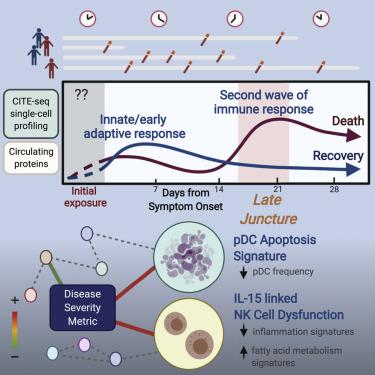Cell ( IF 64.5 ) Pub Date : 2021-02-10 , DOI: 10.1016/j.cell.2021.02.018 Can Liu 1 , Andrew J Martins 2 , William W Lau 3 , Nicholas Rachmaninoff 1 , Jinguo Chen 4 , Luisa Imberti 5 , Darius Mostaghimi 2 , Danielle L Fink 6 , Peter D Burbelo 7 , Kerry Dobbs 8 , Ottavia M Delmonte 8 , Neha Bansal 2 , Laura Failla 2 , Alessandra Sottini 5 , Eugenia Quiros-Roldan 9 , Kyu Lee Han 4 , Brian A Sellers 4 , Foo Cheung 4 , Rachel Sparks 2 , Tae-Wook Chun 10 , Susan Moir 10 , Michail S Lionakis 8 , , , Camillo Rossi 11 , Helen C Su 8 , Douglas B Kuhns 6 , Jeffrey I Cohen 12 , Luigi D Notarangelo 8 , John S Tsang 13

|
COVID-19 exhibits extensive patient-to-patient heterogeneity. To link immune response variation to disease severity and outcome over time, we longitudinally assessed circulating proteins as well as 188 surface protein markers, transcriptome, and T cell receptor sequence simultaneously in single peripheral immune cells from COVID-19 patients. Conditional-independence network analysis revealed primary correlates of disease severity, including gene expression signatures of apoptosis in plasmacytoid dendritic cells and attenuated inflammation but increased fatty acid metabolism in CD56dimCD16hi NK cells linked positively to circulating interleukin (IL)-15. CD8+ T cell activation was apparent without signs of exhaustion. Although cellular inflammation was depressed in severe patients early after hospitalization, it became elevated by days 17–23 post symptom onset, suggestive of a late wave of inflammatory responses. Furthermore, circulating protein trajectories at this time were divergent between and predictive of recovery versus fatal outcomes. Our findings stress the importance of timing in the analysis, clinical monitoring, and therapeutic intervention of COVID-19.
中文翻译:

时间分辨系统免疫学揭示了与致命的 COVID-19 相关的晚期关键点
COVID-19 表现出广泛的患者异质性。为了将免疫反应变化与疾病严重程度和结果随时间的推移联系起来,我们同时纵向评估了来自 COVID-19 患者的单个外周免疫细胞中的循环蛋白以及 188 种表面蛋白标记物、转录组和 T 细胞受体序列。条件独立网络分析揭示了疾病严重程度的主要相关性,包括浆细胞样树突状细胞凋亡的基因表达特征,以及与循环白细胞介素 (IL)-15 呈正相关的CD56 dim CD16 hi NK 细胞中炎症减弱但脂肪酸代谢增加。CD8 +T 细胞的激活很明显,没有耗尽的迹象。尽管重症患者入院后早期细胞炎症水平较低,但在症状出现后 17-23 天细胞炎症水平升高,提示存在晚期炎症反应。此外,此时的循环蛋白质轨迹在恢复与致命结果之间存在差异,并可预测恢复与致命结果。我们的研究结果强调了在 COVID-19 分析、临床监测和治疗干预中时机的重要性。



























 京公网安备 11010802027423号
京公网安备 11010802027423号